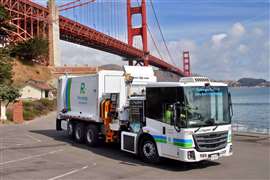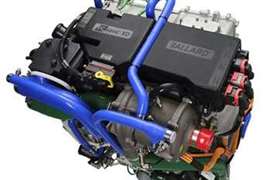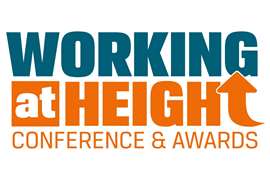Fuel cell electric truck prototype launched at inaugural AMTA innovation expo
10 October 2024
The AZETEC truck was a collaboration among 15 diverse partners.
In addressing the energy transition for on-highway trucking in Canada, the Alberta Motor Transport Association (AMTA) has had a particular interest in the role hydrogen fuel can play. At the inaugural AMTA Industry Innovations Expo in September, the organization gave significant attention to its work on hydrogen fuel cell electric vehicles (FCEV). This included the official launch of the Alberta Zero Emissions Truck Electrification Collaboration (AZETEC) Class 8 truck.
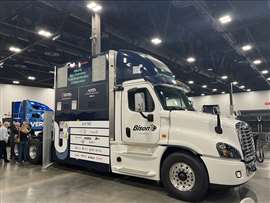 The AZETEC truck on display at the AMTA Industry Innovations Expo in September 2024. (Photo: AMTA)
The AZETEC truck on display at the AMTA Industry Innovations Expo in September 2024. (Photo: AMTA)
“This CA$22 million initiative, supported by CA$7.3 million in initial funding from Emissions Reduction Alberta, represents a collaborative effort of 15 diverse partners in the energy, technology and transportation sectors,” said Tim Bennett, board chair for AMTA, in opening the expo.
Canadian Payload Benefits
Aside from its hydrogen-fueled power system, Bennett said the AZETEC truck is also unique in terms of its payload.
“The AZETEC truck breaks ground as the first heavy-duty hydrogen fuel cell vehicle globally designed to support Canadian weights,” Bennett said. “Existing fuel cell vehicles built to U.S. specs require Canadian fleets to reduce their payloads up to 41 percent. The AZETEC trucks solve this problem. They allow full capacity freight transportation at Canadian weights while also being engineered to handle challenges for winters and long-distance hauls.”
David Layzell, a professor at the University of Calgary as well as the director of its Canadian Energy Systems Analysis Research (CESAR) initiative, said that battery electric (BE) trucks tend to have a higher gross vehicle weight rating (GVWR) than their FCEV counterparts. However, the AZETEC truck is slated to change that.
“This is what makes the AZETEC truck different,” he said. “Basically, the AZETEC truck is about 63.5 tons gross vehicle weight and really starting to get into that range of what Alberta [needs] and what we need in Canada, which are vehicles that can drive hundreds and hundreds of kilometers between refuel.”
FCEVs Address Obstacles
Layzell noted that diesel-fueled Class 8 trucks in Canada account for 5 percent of the country’s greenhouse gas (GHG) emissions and 19 percent of total emissions from transportation. To mitigate this requires alternatives that he said must be credible, compelling and capable of achieving the task.
“Hydrogen fuel cell electric vehicles have the potential to meet this challenge, especially in a province like Alberta and in a country like Canada,” Layzell said.
Citing overall benefits that make them possible, such as Canadian fuel cell production as well as the production of hydrogen from natural gas and electrolysis, Layzell said there’s a strong case to be made for FCEVs as alternatives to diesel.
“Fuel cell electric vehicles are more efficient than internal combustion engines in converting fuel into vehicle motion,” Layzell said. “Also, in a mature hydrogen economy, it should be possible to deliver zero emission freight transportation at a cost that is similar to or even potentially lower than the cost of freight transportation today.”
Clean Sheet Design
In discussing the AZETEC truck’s 2019 origins, Jeff Grant, vice president of transportation solutions for Canadian hydrogen energy solutions provider HTEC, said that the collaborators had to start with a clean sheet.
“We had no OEMs willing to work at the duty cycle and the weights that this truck is designed to,” he said. “So, right at the beginning, we had to create the vehicle team, the design from the ground up. We had to create an infrastructure leveraging some of the existing assets that we had. It was really sort of a ‘start from scratch’ type thing.”
Grant called the AZETEC project a catalyst for on-highway hydrogen transportation in Alberta.
“Because we were able to get some momentum, we were able to get some support from government — get some initial infrastructure in place,” he said.
Grant added, “You can see Edmonton [Alberta] has become this hub of hydrogen activity for transportation. And I like to think that this AZETEC project had a hand in kicking that off really quickly.”
Two Axles Required
One collaboration partner on the AZETEC projects was powertrain maker Dana. Steve Slesinski, director of global product planning for Dana, said the company’s main contribution to the AZETEC truck was the e-propulsion system.
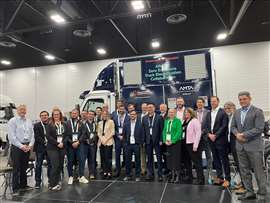 AZETEC project collaborators are pictured in front of the prototype at the AMTA Industry Innovations Expo. (Photo: AMTA)
AZETEC project collaborators are pictured in front of the prototype at the AMTA Industry Innovations Expo. (Photo: AMTA)
“We call it the Zero-8 e-axle,” he said. “Underneath the truck, you can see the large e-axle that propels this vehicle. We also have the motors, the inverters, the controllers as well as a second driving axle, which is unique.”
Slesinski explained that the two axles were required to address the weight requirements necessary for project success. He added that a particular challenge was integrating the e-axles, as one is a three-speed axle, and one is a zero-speed axle.
That was not the only challenge, Slesinski said, echoing Grant in saying that the project required significant original thinking.
“We actually had to invent a lot of things on the fly as we went along,” Slesinski said. “We were able to have a high-energy fuel cell system commissioned on the vehicle. And we accomplished a lot of technical things, such as putting two driving axles on a vehicle and coordinating how those axles respond in terms of the electronic stability control, the APS systems, all while meeting the Canadian vehicle safety systems requirements for a nonconventional vehicle.”
The AZETEC truck is powered by four 70kW FCMove-HD fuel cell power modules provided by Ballard Power Systems.
“At the beginning of this project, it was under development for use in bus applications,” said Cara Startek, vice president of technology solutions and program management for Ballard. She added, “When contacted by this team and given the incredible challenge of putting something together for a truck, we took that product in its current development state and put it in a truck. Now we do that — not at the same level or the same magnitude as this vehicle — but it has been proven for truck applications.”
Additional Commercialization Hurdles
Jamie Ally, CEO of Toronto, Ontario-based hydrogen electric truck maker Elemental Trucks, previously worked for Almon Equipment, also of Toronto. While at Almon, Ally worked with Ballard to build and integrate the hydrogen range extenders on the AZETEC truck. He said that Elemental Trucks is ready now to begin building commercial FCEVs.
“As information about the AZETEC project started getting out there, we started getting approached by companies that were looking for 63.5-ton zero-emission trucks,” Ally said. “And we were the only ones involved in building them as part of this team. So that’s why we launched Elemental Trucks.”
He added that the slow pace of zero emission vehicle commercialization in North America is a hurdle the industry needs to overcome.
“In Canada, we have an amazing technological lead,” Ally said. “We’re a globally recognized technological leader in fuel cells and hydrogen, but the uptake has been relatively low, so we have to find a way to solve that problem.”
According to Ally, 3000 fuel cell-driven trucks were manufactured in China in 2023, whereas in North America, that number is in the dozens.
“To maintain our technological lead, we’re going to need to find a way to increase demand and production massively,” he said. “And one thing that always comes up when you talk about commercialization is the cost — the total cost of ownership of the truck and the cost of acquiring the vehicle. The cost is still a bit high, and it’s our job as an industry to get that down.”
MAGAZINE
NEWSLETTER
The gold standard in market research
Off-Highway Research offers a library of more than 200 regularly updated reports, providing forensic detail on key aspects of the construction equipment industry.
Our detailed insights and expert analyses are used by over 500 of the world’s largest and most successful suppliers, manufacturers and distributers, to inform their strategic plans and deliver profitable growth.




